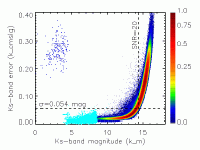
iv. Bright Source Photometry
The Level 1 Specifications place three requirements on saturated
star photometry (specifically "Read_1" photometry).
There are no Level 1 requirements associated with sources that saturated even the 51 ms "Read_1" exposure (designated by rd_flg=3). These sources do have large uncertainties significantly in excess of the Level 1 Specifications for fainter sources.
Requirements 1 and 2 are addressed in the Photometric Precision subsection (see VI.1c), which discusses uncertainties derived from repeated observation across virtually the entire flux range observed in 2MASS. The relevant diagram is reproduced in Figure 1 and shows that the uncertainty in the magnitude range 4.0<Ks [mag] <8.0 is substantially better than the 10%/5% requirements in items 1 and 2 above.

|
| Figure 1 |
A means has not been found to rigorously statistically validate item 3 above -- demonstrating less than 2% bias across the Read_1 (Ks = 4.0--8.0 mag) regime -- from internal Survey data.
Bias can be addressed at the "faint" end of the saturation regime, due to some overlap between the 1.3 s Read_2-Read_1 photometry (rd_flg=2) and the 51 ms Read_1 photometry (rd_flg=1), since, in addition to saturated stars, the 51 ms Read_1 pipeline photometers stars fainter than the Read_2-Read_1 saturation threshold. Quality assurance during the processing monitored the overlap between these two assessments of a star's magnitude. Figure 2 shows a typical result. In the figure the blue dots represent legitimate 1.3 s Read_2-Read1 (rd_flg=2) detections, which transition to saturated 1.3 s detections at the red points. Near the transition the the two magnitudes agree well. In the regime of red dots the diagrams show deviation, because the Read_2-Read_1 pipeline is operating on a saturated image. At faint magnitudes the diagrams show deviation, because the singly-correlated 51 ms Read_1 integration becomes a poor estimator of flux when there is little detectable flux.
Although this result does not bear directly on the bias in saturated observations, it does show that the 51 ms integration frames were consistently tied to the 1.3 s frames at the crossover point between two methods of photometry, and that the Read_2-Read_1 1.3 s integration photometry was linear right up to the saturation threshold. The 51 ms Read_1 saturation threshold was characterized and implemented in a similar fashion, and the linearity characteristics at this threshold should be similar.
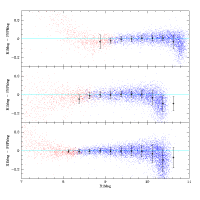
|
| Figure 2 |
Direct comparison with externally-determined calibration networks provides both a test of the accuracy of Read_1 photometry as a whole and an estimate of the bias between the bright end and faint end of the Read_1 saturation range. Since these other systems suffer from the same validation challenges as 2MASS, differences may characterize biases in the other systems, rather than in 2MASS. Nevertheless, the ensemble should provide upper limits to bias in 2MASS.
Below are comparisons of Read_1 photometry with established calibrator magnitudes in five different popular calibration systems. The green points in Figures 3--7 below correspond to 2MASS rd_flg=1 sources (while the red points illustrate the performance of the algorithm that extracted stars which were saturated, even in the 51 ms exposures -- rd_flg=3 -- for which there are no specifications). Table 1 below (not yet available) quantifies the mean zeropoint offset for each photometric system. The table also quantifies the difference in zeropoint offset (bias) between the faint end and bright end of the Read_1 regime for each system. If fewer than five stars appear in either of the magnitude bins for this calculation, a result does not appear in the table.
From these tabulated results the Science Team concludes that the photometric bias across the Read_1 range is certainly <4%, and possibly within the specification of 2%.

| 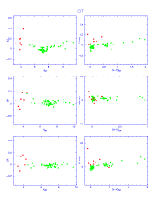
| 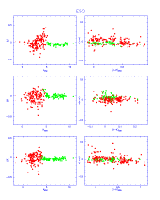
|
| Figure 3 | Figure 4 | Figure 5 |

| 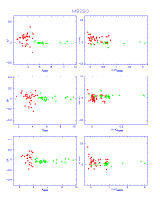
|
| Figure 6 | Figure 7 |
| System | J offset | H offset | Ks offset | J bias (5-6 mag) vs. (8-9 mag) |
H bias (5-6 mag) vs. (8-9 mag) | Ks bias (4-5 mag) vs. (8-9 mag) |
| AAO | -0.083 +/- 0.012 | -0.022 +/- 0.007 | -0.039 +/- 0.006 | ---- | ---- | ---- |
| CIT | 0.001 +/- 0.007 | 0.018 +/- 0.005 | -0.017 +/- 0.003 | ---- | ---- | ---- |
| ESO | -0.056 +/- 0.003 | 0.011 +/- 0.005 | -0.041 +/- 0.003 | 0.018 +/- 0.009 | 0.013 +/- 0.009 | -0.016 +/- 0.007 |
| MSSSO | -0.016 +/- 0.004 | 0.007 +/- 0.006 | -0.032 +/- 0.004 | ---- | ---- | ---- |
| SAAO | -0.040 +/- 0.003 | 0.026 +/- 0.004 | -0.016 +/- 0.002 | 0.023 +/- 0.006 | 0.016 +/- 0.010 | -0.007 +/- 0.006 |
To be complete in this discussion one should note that there is a known and characterized source of bias in the Read_1 photometry immediately adjacent to the Read_1 saturation magnitude. This bias arises because Read_1 photometry is calculated from only those apparitions (of the six possible for a given source) that were unsaturated. For a source at the saturation threshold, effects, such as intrapixel quantum efficiency variation and instantaneous seeing fluctuations, will cause some of the six apparitions of the source to be saturated, while others will not. The unsaturated apparitions are naturally biased to fainter fluxes, yielding a biased estimate of the star's flux. Users can identify affected sources by consulting the column in the database that lists the number of useful detections of a source in a given band and the number of opportunities for detection (ndet). Read_1 sources with two or fewer surviving unsaturated apparitions can be also identified, because they receive ph_qual='F' -- a flag which means that insufficient data were available to calculate a meaningful uncertainty.
At its conception 2MASS had no intention to extract photometry for
stars which saturated even the 51 millisecond Read_1 exposure.
Thus, the Level 1 Specifications do not even address this flux regime.
Analysis at IPAC demonstrated that reliable fluxes could be extracted
for sources, even as bright as magnitude -4
(e.g.,  Ori and
Ori and  Tau),
using the scattered light wings in the images. These extractions
are called "Read_3" extractions and receive a rd_flg=3 if they appear
as default magnitudes in the database. Figures 3--7 above include Read_3
results for a large number of bright sources and demonstrate that
their photometry is consistent with previously-cataloged magnitudes.
Figure 1 above, which assesses uncertainty
from repeated observations as
a function of magnitude, includes rd_flg=3 sources and shows that the
price of this novel method of flux estimation is excess uncertainty.
Since this subset of Read_3 sources overlaps the brightest visible
stars on the sky, the Science Team deemed it reasonable to include
these very reliable sources at the "Catalog" level, despite their
substantial uncertainty relative to the Level 1 requirement for fainter
stars. Read_3 photometry is biased by seeing.
This seeing correction
has been estimated, but has not been applied to the data, because it
did not demonstrably improve stellar colors when applied, although
it improved the match between 2MASS Read_3 photometry and other catalog
photometry. The biases, expected to be <20% in the worst cases,
lie within the quoted large uncertainties for these sources. The
calibration of these sources is a hybrid between existing
bright calibrators from other photometric systems
and overlap with unsaturated Read_1 photometry.
As such, it has a somewhat different heritage than the rd_flg=2 and
rd_flg=1 photometry, which ultimately tie entirely to the network of
faint near-infrared Survey standards.
Tau),
using the scattered light wings in the images. These extractions
are called "Read_3" extractions and receive a rd_flg=3 if they appear
as default magnitudes in the database. Figures 3--7 above include Read_3
results for a large number of bright sources and demonstrate that
their photometry is consistent with previously-cataloged magnitudes.
Figure 1 above, which assesses uncertainty
from repeated observations as
a function of magnitude, includes rd_flg=3 sources and shows that the
price of this novel method of flux estimation is excess uncertainty.
Since this subset of Read_3 sources overlaps the brightest visible
stars on the sky, the Science Team deemed it reasonable to include
these very reliable sources at the "Catalog" level, despite their
substantial uncertainty relative to the Level 1 requirement for fainter
stars. Read_3 photometry is biased by seeing.
This seeing correction
has been estimated, but has not been applied to the data, because it
did not demonstrably improve stellar colors when applied, although
it improved the match between 2MASS Read_3 photometry and other catalog
photometry. The biases, expected to be <20% in the worst cases,
lie within the quoted large uncertainties for these sources. The
calibration of these sources is a hybrid between existing
bright calibrators from other photometric systems
and overlap with unsaturated Read_1 photometry.
As such, it has a somewhat different heritage than the rd_flg=2 and
rd_flg=1 photometry, which ultimately tie entirely to the network of
faint near-infrared Survey standards.
[Last Updated: 2003 January 31; by M. Skrutskie]